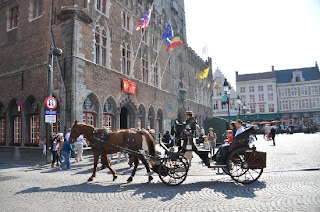Leuven delights
those interested in architecture. The first town wall, churches, monasteries
and abbeys were built in the 11th-12th century but the
Gothic Town Hall, Market Square, Cloth Hall, and many churches flourished when
the new golden age dawned in the 15th century. Other architectural
styles are not as well represented but they can still be found.
During World War I, the Germans came and levelled it with their bombs. The city fathers put their heads together and
made a decision that they would not rebuild the city but instead would restore
it. They built everything exactly as it
was before the war! Again in World War
II the Germans came and levelled Leuven and again, the city fathers decided to
build everything in its original style. The
building materials may not be original but the architectural styles are!

There are
seven magnificent churches in Leuven, the oldest being St. Peter’s Church
dating back to 986. The interior is
amazing but here you will also find two masterpieces from the 15th
century by the Flemish Primitive Dirk Bouts – The Last Supper and The
Martyrdom of Saint Erasmus. If you remember the story of Father Damian who
lived for years among the lepers on the island of Molokai, Hawaii, you will
find his crypt in St. Anthony’s Chapel.
The Damian Centre, in the chapel, provides documentation and information
about his life.
The Town Hall
is an absolute must see! There are 236
statues completely covering the face of the building representing artists,
scholars, eminent citizens of Leuven, and biblical figures all wearing the
clothes of the period in which they lived.
For your
sightseeing pleasure, you will find museums, cemeteries (including a World War
II British Military Cemetery), abbeys, beguinages, parks, and gardens. Stop for at least one night in Leuven.
 Activities include a wildlife safari, horse back riding, hiking, touring Yellowstone National Park, a photograph excursion of the Tetons, and much more. You can join a pre-set tour or have one customized to suit your own family.
Activities include a wildlife safari, horse back riding, hiking, touring Yellowstone National Park, a photograph excursion of the Tetons, and much more. You can join a pre-set tour or have one customized to suit your own family.
 Activities include a wildlife safari, horse back riding, hiking, touring Yellowstone National Park, a photograph excursion of the Tetons, and much more. You can join a pre-set tour or have one customized to suit your own family.
Activities include a wildlife safari, horse back riding, hiking, touring Yellowstone National Park, a photograph excursion of the Tetons, and much more. You can join a pre-set tour or have one customized to suit your own family.





 s
s 












